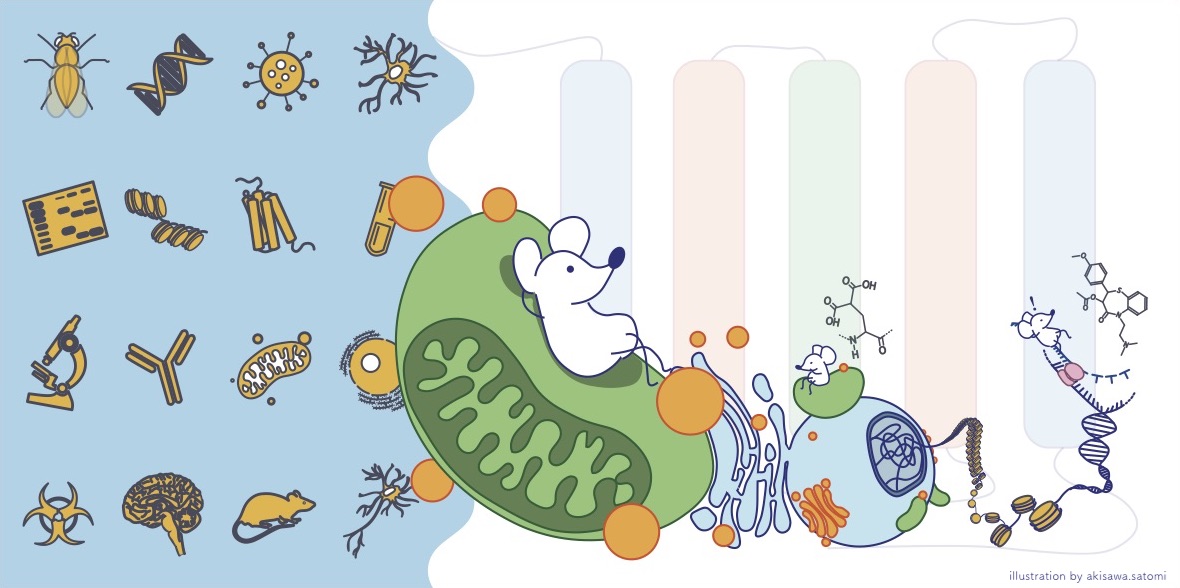INTRODUCTION
Our research goal is to understand how cells integrate numerous external and internal signals into meaningful biological outputs by focusing on (1) post-translational modifications and logistics of proteins, or (2) inter-organelle communications. In addition, we are also studying (3) the interactions between immune and nervous systems and (4) neuroethology using Drosophila. Through these studies, we wish to discover the sophisticated (crazy cool) systems of living organisms for surviving in a complex world.
RESEARCH
Host defense mechanisms against pathogen infection
When mammalian cells get infected with viruses, they activate the innate immune system as a first-line defense mechanism before activating the adaptive counterpart. The RIG-I-like receptor family, which detects virus-derived RNA within infected cells, and its adaptor molecule IPS-1/MAVS play central roles in this innate immune system. IPS-1 is mainly localized on the mitochondrial outer membrane and has been known to trigger host defense mechanisms including type I interferon (IFN) production and cell death (apoptosis). Type I IFN inhibits viral replication within infected cells, and apoptosis of infected cells altruistically prevents viral propagation to surrounding cells. Although both strategies appear to be effective means of suppressing viral replication, ironically they can also be harmful to the host organism in some instances. Therefore, it is reasonable to assume that host cells may regulate use of the two mechanisms to optimize the benefit to the organism in a context dependent manner and efficiently remove the infecting virus. However, it remained unclear whether such differential regulation exists within infected cells and, if it does, how it is controlled. Our laboratory has identified novel modifications and binding molecules of IPS-1 to address this question.
Protein carboxylation
Protein functions are regulated not only by its amino acid sequence but also by various post-translational modifications. Among them, protein carboxylation is a rare but unique post-translational modification in which a carboxyl group are added to glutamate and aspartate residues by a γ-carboxylase GGCX in a vitamin K (VK) dependent manner. To date, about 20 substrates have been identified as GGCX substrates, which regulate limited physiological processes including blood coagulation and bone formation. We are now examining whether this protein carboxylation plays any role in the regulation of immune systems.
Inter-organelle communications
Although organelles have been long assumed to perform their unique functions by their own organizations, recent studies have discovered functional coordination between them through inter-organelle communications, which is being addressed worldwide as new paradigm shift. We have discovered novel interactions between mitochondria and peroxisomes, and between mitochondria and stress granules, and found that these interactions may play important roles in cell physiology (Tanaka et al., Journal of Cell Science, 2019; Aoyama et al., Journal of Immunology, 2020). We are further investigating the role of these inter-organelle communications.
The interactions between immune and nervous systems in health and disease
The central nervous system has long been thought as an immune-privileged site having no direct communication and interaction with the immune system at least under health conditions, due to its functional importance and the structural features of the blood-brain barrier. However, recent studies have revealed (rediscovered) the presence of lymphatic vessels (pathways for immune cells) in the brain, and also the presence of various immune cells in the adult brain through scRNA-seq analysis. Furthermore, it has been also shown that immunodeficient mice, which lack both T cells and B cells, exhibited various behavioral abnormalities, indicating that immune cells play crucial role in the formation of neural circuits and the brain function. We are currently investigating which and how immune cells contribute to the pathogenesis (or alleviation) of viral infections in the brain, neurodegenerative diseases, and psychiatric disorders such as autism and schizophrenia.

PUBLICATIONS
Tomohiko Okazaki
Nao Morimoto
CONTACT
Laboratory of Molecular Cell Biology Institute for Genetic Medicine, Hokkaido University Tomohiko Okazaki Tel:011-706-5525 Fax:011-706-5522 E-mail:okazaki@igm.hokudai.ac.jp

